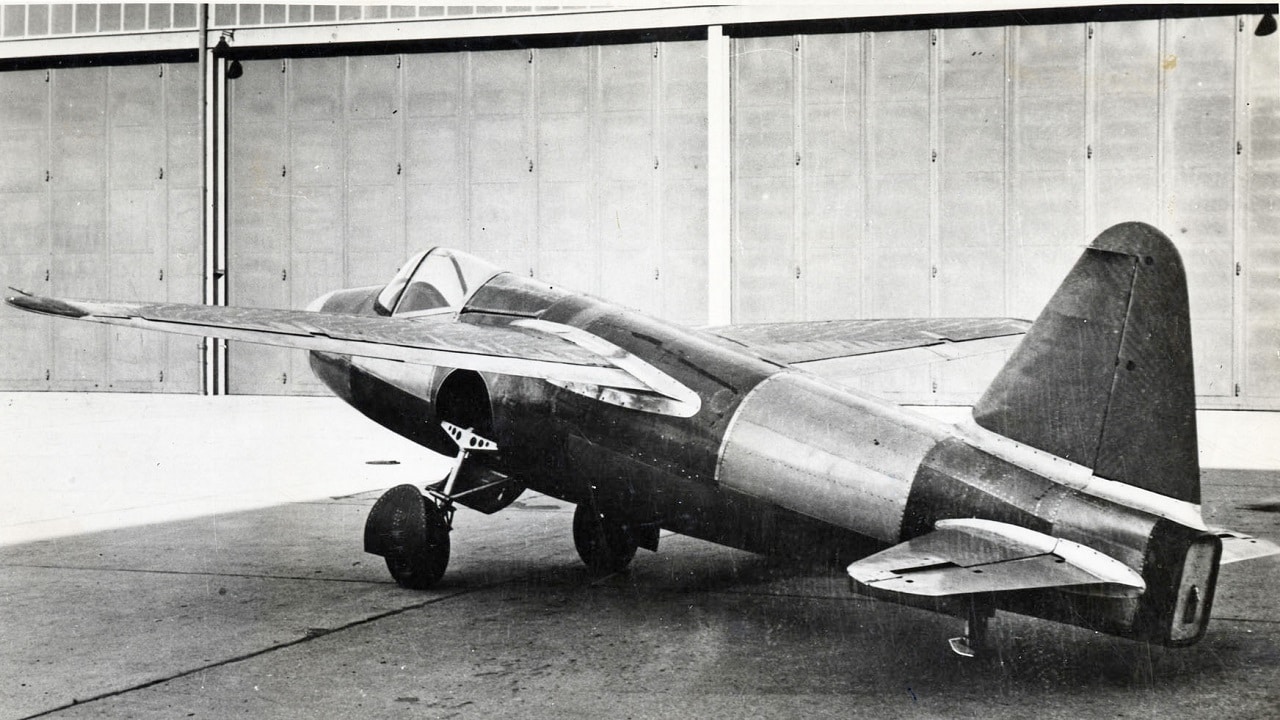Last year, Yours Truly wrote an article for 19FortyFive on the Messerschmitt Me 262 Schwalbe (“Swallow”), the world’s first operational jet fighter and the only jet fighter of WWII to engage in air-to-air combat against manned enemy warplanes (the Allies’ only jet fighter to go operational during that war, the RAF Gloster Meteor, only got to attack unmanned V-1 Buzz Bombs and ground targets before the cataclysmic conflict ended). Now we’re going to talk about the Me 262’s ancestor – and yet another one of many Teutonic technological innovations – albeit from a competing manufacturer: the Heinkel He 178, the world’s first aircraft to fly under turbojet power, and the first practical jet plane.
Heinkel He 178 Initial History & Specifications
The He 178 made her maiden flight – with Flugkapitan (Flight Captain) Erich Warsitz at the controls – on 27 August 1939, a mere four days before the start of World War II via Nazi Germany’s invasion of Poland. The plane was the brainchild of Dr. Ernst Heinkel (1888-1958), an aviation designer and pioneer known for his obsession with high-speed aircraft. Herr Doktor Heinkel’s company, Heinkel Flugzeugwerke, was founded in 1922 and which also produced the He 111– the Luftwaffe’s mainstay bomber for the first four years of WWII, including the Battle of Britain – and the He 176 – the first rocket aircraft – before eventually going defunct in 1965.
Of course, when I refer to Dr. Heinkel as the “brainchild” of the He 178, for the sake of fairness, balance, and historical accuracy, I also need to dole out some of the credit to German physicist and engineer Hans Joachim Pabst van Ohain, whom some have co-dubbed alongside RAF Air Commodore Sir Frank Whittle as “the father of the jet engine.” After all, ‘twas Herr van Ohain who designed the HeS 3B turbojet engine that was used to power Dr. Heinkel’s experimental aircraft. According to the This Day in Aviation website:
“The HeS 3B used a single-stage axial-flow inducer, single-stage centrifugal-flow compressor, reverse-flow combustor cans, and a single-stage radial-inflow turbine. The engine produced 1,102 pounds of thrust (4.902 kilonewtons) at 11,600 r.p.m., burning Diesel fuel. The engine’s maximum speed was 13,000 r.p.m. The HeS 3B was 1.480 meters (4.856 feet) long, 0.930 meters (3.051 feet) in diameter and weighed 360 kilograms (794 pounds).”
Specifications for the He 178’s airframe itself, courtesy of that same website: a fuselage length of 7.48 meters (24.54 feet), a wingspan of 7.20 meters (23.62 feet), and height of 2.10 meters (6.89 feet). Empty weight of 1,620 kilograms (3,572 pounds) and its maximum takeoff weight was 1,998 kilograms (4,406 pounds). “The He 178 V1 was designed for a cruise speed of 580 kilometers per hour (360 miles per hour) and maximum speed of 700 kilometers per hour (435 miles per hour). During flight testing, the highest speed reached was 632 kilometers per hour (393 miles per hour). Its estimated range was 200 kilometers (124 miles).”
Ohain showcased his engine design in 1937 and the design of the aircraft itself began the following year.
Field-Testing Performance and Legacy
The aforementioned Flugkapitan Warsitz’s maiden flight in the He 178 ended somewhat unceremoniously after a bird got sucked in and forced a flameout for the engine; fortunately for the Herr Flugkapitan, he was able to land the aircraft safely.
A second demonstration flight was conducted on 1 November 1939, this time for the benefit of Luftwaffe Generaloberst (Colonel General) Ernst Udet – who had been Germany’s second-highest scoring air ace during WWI after the Red Baron – Generalfeldmarschall (General Field Marshal) Erhard Milch, and engineer Helmut Schlep. This flight lasted 10 minutes, but the three guests of honor were underwhelmed. According to The Aviation History Online Museum:
“[F]rom the standpoint of Udet, Milch and Schelp they rejected it for the following reasons:
•The war was on.
•It was not a military aircraft.
•It had no weapons.
•Heinkel was behind on his production schedules and thought to be goofing around with non-productive developmental programs.”
However, the single-engine He 178 would soon pave the way for the twin-engine He 280, which was the first turbojet-powered *fighter* aircraft in the world, i.e. this one *did* come with weapons, However, it was the Me 262 that would end up making jet combat history.
Where Is It Now?
Well, you won’t be able to find the genuine He 178 anywhere, as it was destroyed in a 1943 Allied bombing raid whilst on display at the Berlin Aviation Museum, which was rebuilt in 1982 as the Deutsches Technikmuseum (German Technical Museum). That said, my fellow military aviation history buffs can still indulge their curiosity somewhat by viewing a replica on static display at the Planes of Fame Air Museum in Chino, California; museum admission prices are $18.00 USD for adults and $8.00 for kiddos.
Christian D. Orr is a former Air Force Security Forces officer, Federal law enforcement officer, and private military contractor (with assignments worked in Iraq, the United Arab Emirates, Kosovo, Japan, Germany, and the Pentagon). Chris holds a B.A. in International Relations from the University of Southern California (USC) and an M.A. in Intelligence Studies (concentration in Terrorism Studies) from American Military University (AMU). He has also been published in The Daily Torch and The Journal of Intelligence and Cyber Security. Last but not least, he is a Companion of the Order of the Naval Order of the United States (NOUS).

